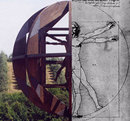|
|
Skidmore
College: Liberal Studies1
Fall 2004
The
Tang Teaching Museum Fall 2004
Paradise
and Plumage: Chinese Connections in Tibetan Arhat Painting
September 25, 2004 - January 2, 2005
Organized by Rob Linrothe, Associate
Professor of Art History at Skidmore College in collaboration with the
Rubin Museum of Art, New York.
|
By
the fourteenth century, cultural exchanges between the courts at
the imperial capitols of China
and the religious centers of Tibet
were a regular occurrence. Imperial
envoys visited Tibet
bearing gifts of sculptures, paintings and other precious objects;
likewise, Tibetan religious leaders reciprocated, bringing Tibetan
works of art to the Chinese courts. The Chinese products of this
cultural exchange were particularly admired in Tibet,
where artists had access to both the objects themselves and paintings
that represented them.
Tibetan
paintings depicting Arhats (early Indian
disciples of the Buddha) clearly exhibit the artistic consequences
of this exchange. The paintings display the gnarled pine trees,
fantastic birds, deer, exotic flowers, and other objects that are
common in various genres of Chinese painting, and also contain other
emblems of Chinese literati culture like furniture, vases, tapestries,
and scholar’s rocks. By the fifteenth century, Chinese court painters
were themselves producing exquisite sets of Arhat
paintings embellished with gold and expensive mineral pigments. Nearly identical Tibetan versions of these paintings
also exist, and comparisons between the Chinese and Tibetan versions
of the compositions are revealing of the cultural values of the
two groups.
This
focused exhibition illustrates the artistic interchange of the two
cultures by juxtaposing paintings and objects from China
and Tibet
of the fourteenth through eighteenth century.
The works include tangka
paintings (Tibetan scroll paintings originally mounted in silk brocade),
Chinese hanging scrolls, album leaves, porcelain ceramics, scholar’s
rocks, and semi-precious treasure-offerings such as coral and turquoise.
|
|
Elevator
Music 3: Michelle Nagai October
15, 2004 - January
2, 2005
Michelle
Nagai is an electroacoustic composer, performance
artist, and improviser who creates site-specific
performances, radio broadcasts and installations of an interdisciplinary
nature. Her creative activities
find their basis in the theories of acoustic ecology—the relationships
between sounds and the environments that create them, and the way that
those relationships act on and influence human beings.
At
the Tang Museum,
in collaboration with 91.1 WSPN Skidmore College Radio, Nagai will continue
her traveling sound project EC(h)OLOCATOR. EC(h)OLOCATOR aims
to utilize the unique sonic character of a place to create soundscapes
that awaken the senses, enliven a connection to place, and encourage deeper,
more thoughtful modes of listening. Its
live broadcasts are designed to share creative control of the project
between community members, radio station staff, producers, and Nagai herself. The project will culminate with a live broadcast
on WSPN and an installation in the Tang’s elevator.
The Elevator Music series is organized by Tang Curatorial
Assistant, Gretchen Wagner in collaboration with the artist and is supported
by the Friends of the Tang.
A
Very Liquid Heaven, October
23, 2004 – June 5, 2005
Organized by Mary Crone-Odekon, associate professor of Physics, and Margo
Mensing, associate profesor of Art, Skidmore College.
|
In
his Principles of Philosophy
of 1644, Rene Descartes described the earth as surrounded on all
sides by a very liquid heaven. Although
later discoveries discredited this idea, in a sense Descartes was
on target. Modern astronomy
reveals stars not as hard, fixed objects, but as pulsing plasmas,
and interstellar space not as pure void, but as diffuse clouds of
atoms and molecules.
A Very Liquid Heaven
explores the essence of permanence versus mutability by posing questions
regarding the nature of time, the constancy of experience, and the
perception of change. These
questions will be examined through an investigation of the changing
human perception of stars based on physical observation, technical
postulation, and artistic imagination.
Traditionally, stars have been characterized as immutable
points of light, but in the last one hundred years scientists have
redefined these seemingly timeless objects as very active bodies—stars
dramatically pulse, even catastrophically explode. Does this change in the ways stars are perceived
help to make the stars more comprehensible, more real?
|

|
|
This
exhibit will feature historical artifacts, star charts, maps, globes,
and photographs of astronomical bodies, as well as recent art by
Kiki Smith, Russell Crotty, John
Torreano, Bill Viola, and Sebastian Romo,
among others. Additionally,
three performances of Music
for a Summer Evening: Makrokosmos III
(a work for two pianos and a wide array of percussion instruments,
composed by George Crumb) will open the exhibition.
The performances, featuring Skidmore faculty musicians and
a dance choreographed and performed by Debra Fernandez, will take
place on October 14, 15, and 17.
Organized
by Associate Professor of Physics, Mary Crone-Odekon,
Associate Professor of Art, Margo Mensing,
and Tang Curator, Ian Berry. The project is supported by Larry and Beverly
St. Clair, Wellesley, Massachusetts,
and the Friends of the Tang.
|
|
